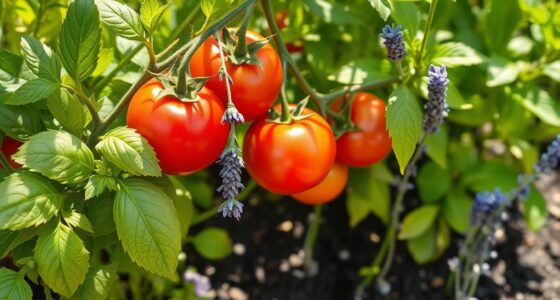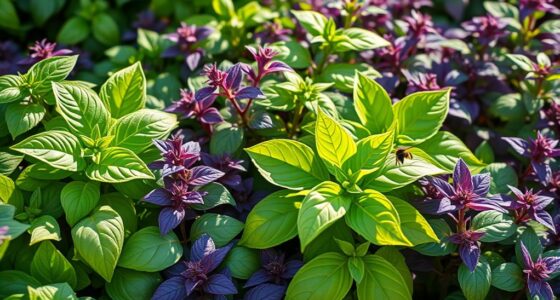Imagine the joy of pulling vibrant, crunchy carrots straight from your garden, their sweet scent filling the air. Growing carrots is not just about cultivating a delicious vegetable; it’s about nurturing a living ecosystem where every plant plays a crucial role. However, these beloved roots can be sensitive, requiring the right conditions and companions to flourish. By understanding the concept of carrot companion plants, you’ll not only enhance your pest management efforts but also maximize yields in ways you never thought possible. This guide will help you discover the unique partnerships in your garden that can transform not just your carrots, but your entire gardening experience.
Key Takeaways
- Companion planting can improve your garden’s health.
- Carrots thrive alongside specific companion plants.
- Effective pest management enhances growth and yields.
- Vegetable pairing fosters a more productive garden ecosystem.
- Understanding plant interactions is key for successful gardening.
- Caring for your plants holistically leads to better harvests.
Introduction to Carrots and Their Growing Needs
Carrots are a popular choice for home gardeners, thanks to their delicious flavor and versatility in the kitchen. Understanding the essentials for successful carrot growth is essential for maximizing your harvest. These vegetables thrive best in well-drained, loose soil. The soil requirements for carrots include rich potassium and phosphorus to encourage healthy development. Well-prepared soil not only enhances growth but also minimizes the risk of disease.
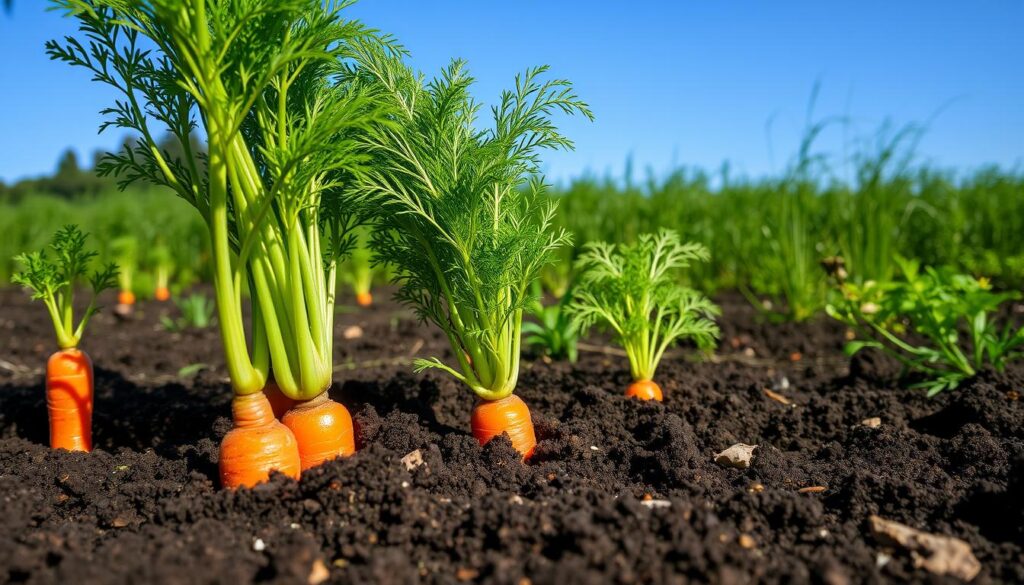
Proper sun exposure plays a crucial role in the production of sweet, tender roots. Carrots require ample sunlight, ideally around 6 to 8 hours a day. When planting, remember that carrots prefer cooler temperatures, making early spring or fall the best times for sowing. Notably, these root vegetables take approximately 70 to 90 days to mature.
An essential consideration for your garden is managing pest vulnerabilities. While carrots are delicious, they attract a variety of undesirable insects. Implementing companion planting can help keep these pests at bay and ensure your carrots grow strong and healthy. By understanding each of these factors, you set yourself up for a fruitful carrot-growing experience.
The Benefits of Companion Planting
Engaging in the practice of companion planting offers significant benefits that can transform your gardening experience. This method allows you to create a balanced ecosystem where plants support each other’s growth and health. One of the most appealing benefits of companion planting is the ability to reduce pests naturally. By selecting plant pairs that deter harmful insects, you can protect your carrots without relying on harmful chemicals.
Another noteworthy advantage involves the potential to increase yields. When plants are strategically paired, they can share nutrients and moisture more effectively, leading to a more abundant harvest. This cooperation not only boosts productivity but enhances the overall biodiversity of your garden, making it a thriving habitat.
Improving plant health stands as one of the most crucial outcomes of this method. Companion plants can provide vital shade or support, protecting their neighbors from extreme weather conditions. Furthermore, they can facilitate better nutrient uptake, promoting stronger and healthier plants.
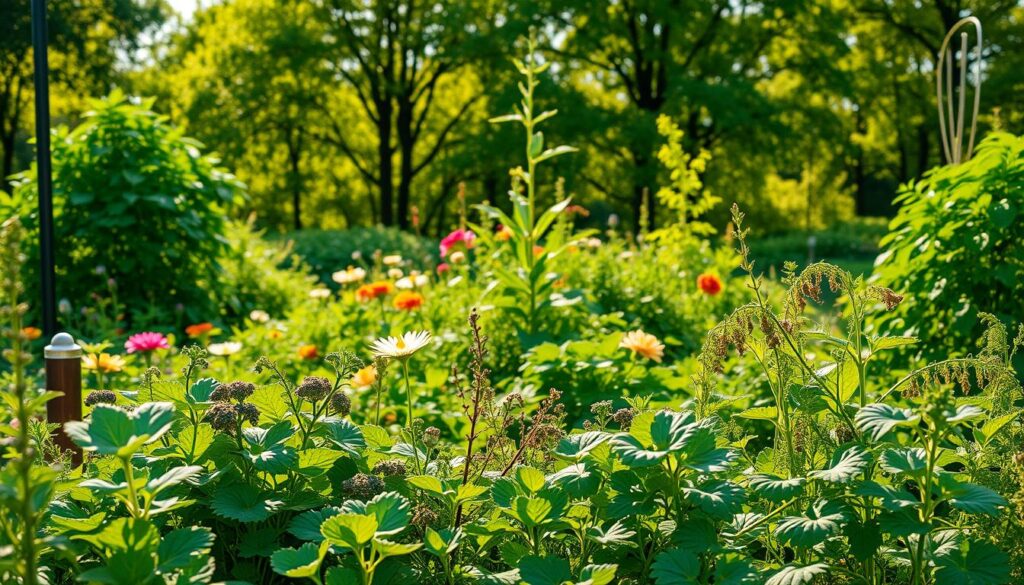
Understanding the Ideal Conditions for Carrot Growth
To achieve vibrant, flavorful carrots, it’s essential to understand the ideal conditions for carrots. These root vegetables flourish best in sandy, loamy soil that allows for deep root penetration. The right soil type not only supports growth but also plays a significant role in determining the size and quality of your harvest.
Maintaining consistent moisture in the soil is critical for carrot development. Carrots thrive when their soil is moist but not waterlogged. Uneven watering can lead to stress, which can negatively affect growth and flavor. Aim for regular watering to keep the soil just right.
Temperature also influences carrot growth. Carrots prefer cooler conditions, with an ideal growing temperature ranging from 60°F to 70°F. This temperature range optimizes growth while preventing premature bolting. Planting during the cooler months can improve your chances of a successful harvest.
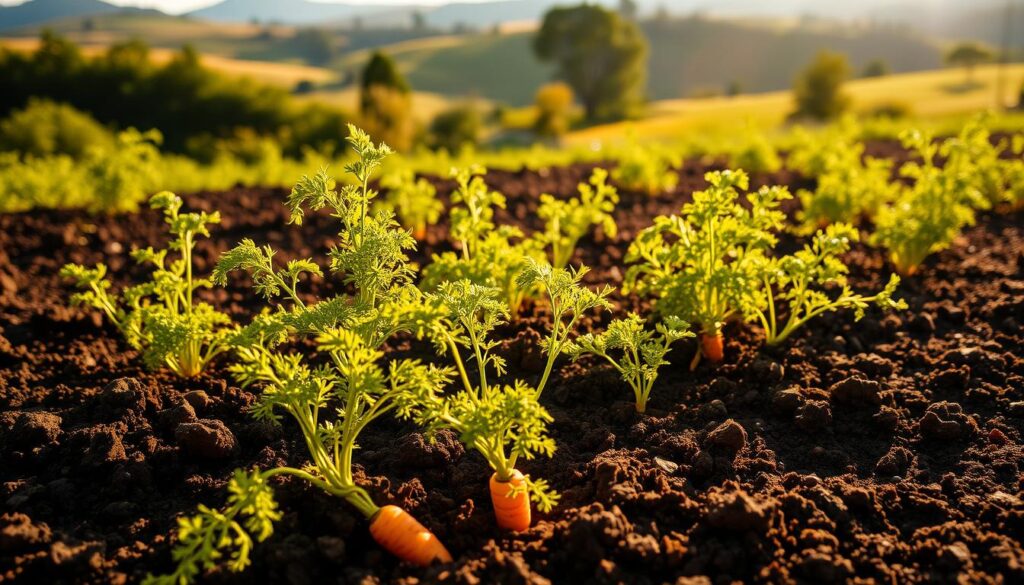
Creating and maintaining these optimal conditions encourages healthy carrot production. Pay close attention to soil type, moisture levels, and temperature when planning your carrot garden to ensure the best results. The balance of these factors will give your carrots the perfect environment to flourish.
Best Carrot Companion Plants
When it comes to optimizing your carrot garden, understanding the best companion plants for carrots can make a significant difference. These plants not only enhance the growth promotion of carrots but also assist in effective pest management. Choosing the right companions creates a thriving ecosystem that benefits your crop’s health.
Why Marigolds Are a Great Choice
Marigolds are a favorite among gardeners for good reason. Their strong fragrance acts as a natural repellent for pests like carrot rust flies and aphids. Planting marigolds around your carrot beds not only provides pest management but also boosts the carotenoid and sugar content of the carrots. This combination results in flavorsome roots while adding vibrant color to your garden.
The Role of Scallions in Pest Management
Scallions belong to the Allium family and bring many advantages when grown alongside carrots. Their pungent odor deters pests such as carrot flies that might threaten your crop. Furthermore, scallions mature faster than carrots, ensuring they won’t steal crucial nutrients from the soil. Positioning scallions alongside carrots creates a protective barrier that enhances your garden’s overall health.
Complementary Growth with Onions
Onions serve as another stellar companion plant. Their distinctive aroma helps repel various pests that could harm carrots. Given onions’ slow-growing nature, they can be planted simultaneously with carrots without competing for resources. Their shallow roots do not interfere with the deeper-rooted carrot plants, which promotes healthy growth for both species.
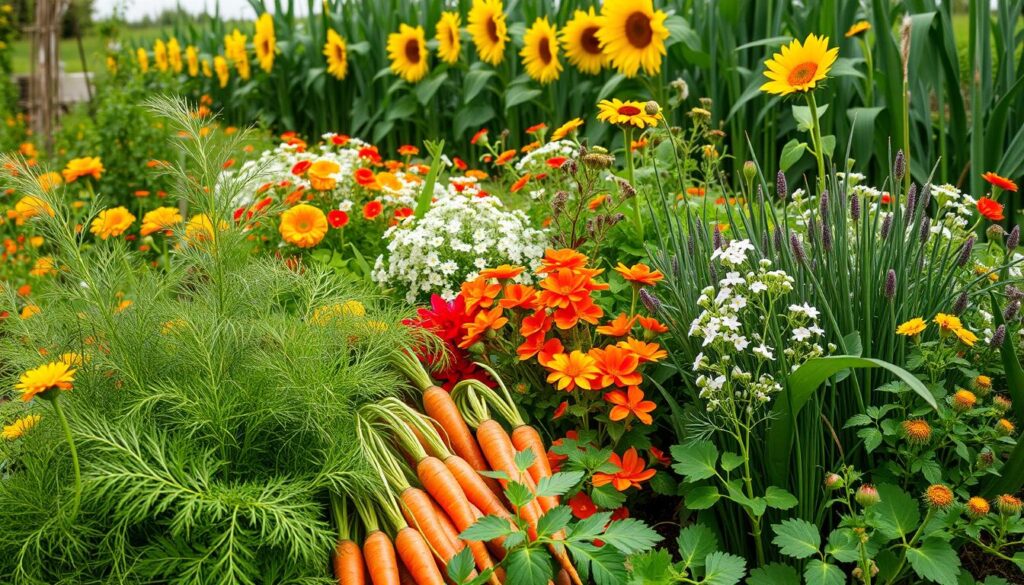
Flowers That Support Carrot Growth
Incorporating flowers into your carrot garden not only enhances its beauty but also provides numerous benefits for your crops. These flowers can attract beneficial insects and act as natural pest deterrents. Utilizing the right flowers for carrot growth can significantly improve overall vegetable health, ensuring robust yields and minimal pest damage.
Attracting Beneficial Insects with Borage
Borage is an exceptional flower that attracts beneficial insects like bees and hoverflies. These pollinators boost your carrot plants’ fertility and health. Additionally, borage plants deter pests that could otherwise harm your carrot crop. Their deep root system enhances soil nutrient availability for nearby vegetables, establishing an environment conducive to carrot growth. Ensure ample space between borage and your carrot seedlings to maintain good air flow, which is crucial for healthy plant development.
Using Daffodils to Deter Rodents
Daffodils serve as a natural pest deterrent due to their toxicity to common rodents such as squirrels and voles. By planting daffodils around the perimeter of your garden, you can create a barrier that protects your carrots from these potential threats. Their bright blooms provide a colorful display while safeguarding your vegetables and maintaining a beautiful garden space.
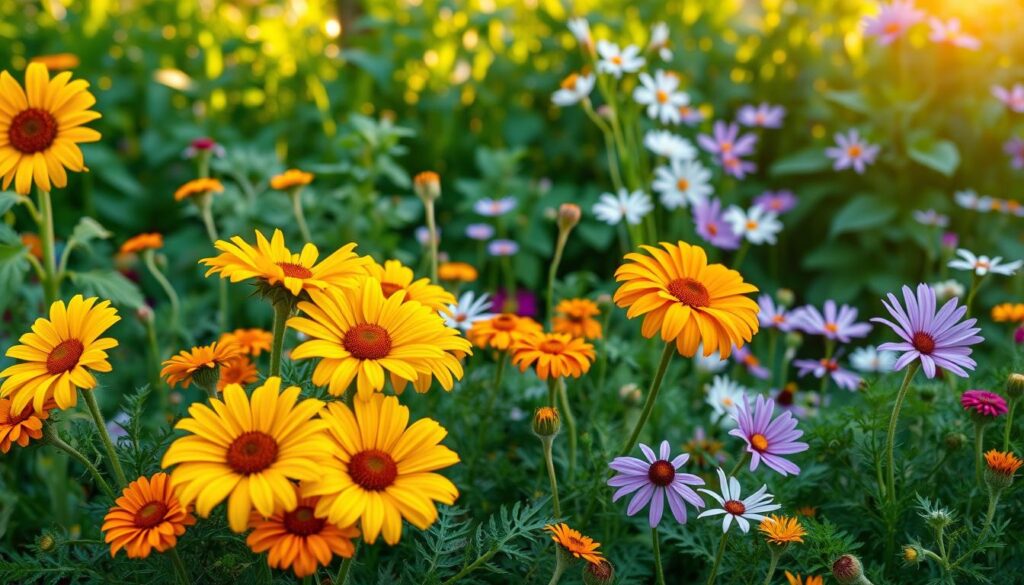
Herbs That Make Good Neighbors for Carrots
Planting herbs for carrot companion planting can dramatically enhance your garden’s productivity and overall health. Certain herbs not only enrich the soil but also provide essential benefits like flavor improvement and pest protection.
The Flavor Benefits of Cilantro
Cilantro is an outstanding companion for carrots. This herb thrives in cool weather and its blooms attract beneficial predatory insects that help keep pests at bay. The flavorful leaves of cilantro can complement carrots, enhancing the overall culinary experience of your harvest.
Oregano’s Pest-Repelling Qualities
Oregano is celebrated for its pest-repelling qualities. Its essential oils can drive away nematodes and various harmful fly pests that may threaten your carrots. By incorporating oregano into your garden, you not only ensure pest protection but also promote the flavor improvement of your carrots when they grow side by side.
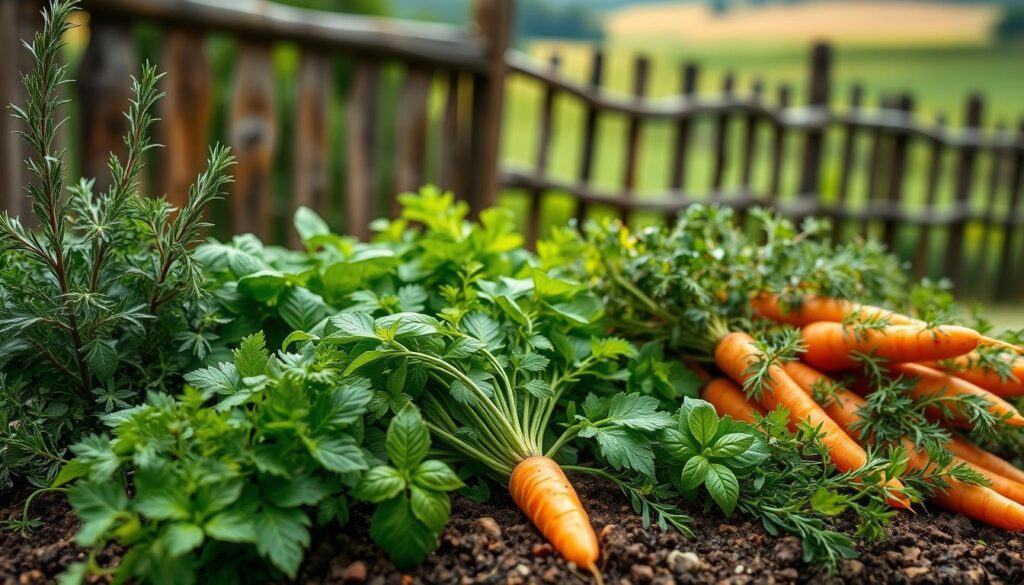
| Herb | Benefits | Flavor Improvement |
|---|---|---|
| Cilantro | Attracts beneficial insects and repels pests | Enhances the flavor of carrots |
| Oregano | Repels nematodes and harmful flies | Improves flavor when planted with carrots |
Utilizing these herbs effectively can enhance your carrot growth while ensuring a vibrant and productive garden space.
Vegetables That Pair Well with Carrots
Choosing the right vegetables to plant with carrots can significantly enhance your garden’s overall yield. The concept of companion planting allows you to create beneficial plant pairings that promote healthy growth while maximizing space. Two standout examples of excellent companions for carrots are tomatoes and peas.
Tomatoes: When Carrots Love Tomatoes
Tomatoes serve as a superb companion to carrots, offering shade that helps protect them from harsh sunlight. This shade can be particularly valuable during the warmer months. Furthermore, tomatoes attract beneficial wasps that help control pests, creating a healthier environment for your carrots. To ensure optimal growth for both plants, maintain proper spacing, allowing each to access necessary sunlight and moisture without competition.
How Peas Complement Carrots’ Growth
Peas are another fantastic option when considering vegetables to plant with carrots. Both thrive in similar cooler temperatures, making them well-suited for companion planting. The shallow roots of peas do not disturb the deep-growing carrot roots, allowing both to flourish concurrently. Additionally, peas aid in fixing nitrogen in the soil, which is invaluable for carrot growth.

| Vegetable | Benefits of Pairing with Carrots |
|---|---|
| Tomatoes | Provides shade and attracts beneficial wasps for pest control. |
| Peas | Shallow roots and nitrogen-fixing properties benefit carrot growth. |
Maximizing Garden Space with Carrot Companion Plants
When you think about garden space optimization, companion planting emerges as a powerful technique to enhance productivity. By selecting the right combination of plants, you can ensure that every inch of your garden bed serves a purpose. Carrots, with their slow growth rate, can benefit tremendously from a well-planned companion planting strategy.
For instance, pairing carrots with fast-growing crops like radishes or lettuce allows you to maximize yields. As the quick-maturing plants are harvested, the carrots continue to thrive underground. This not only makes efficient use of space but also fosters a healthier growing environment, as some companion plants help deter pests that may threaten your carrot crop.
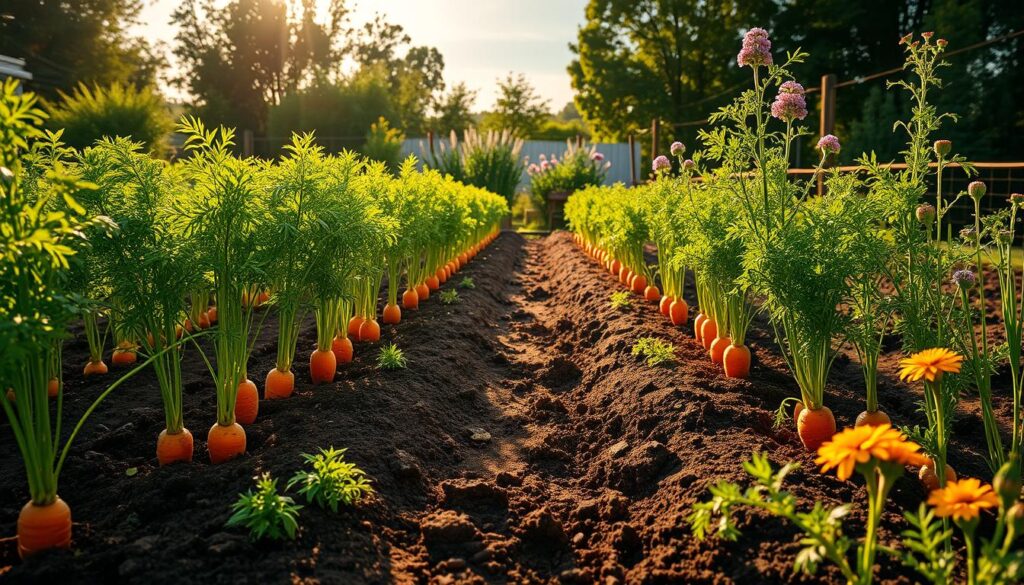
Consider implementing a rotation system that utilizes companion planting alongside seasonal crops. By planning your garden layout strategically, you can create a dynamic ecosystem that supports plant health and soil quality while maximizing yields throughout the growing season. With careful consideration, you can transform your garden space into a productive haven.
Common Mistakes in Companion Planting
Companion planting can significantly enhance your garden experience, yet it comes with its share of pitfalls that you must navigate. One of the primary companion planting errors is misjudging the plant height or spacing needed for optimal growth. This can lead to unnecessary competition among your plants, ultimately affecting your crop yield. Understanding each plant’s specific requirements is crucial in avoiding these common mistakes.
Another area where gardeners falter involves mixing incompatible plant families. Some plant combinations may seem beneficial, but they can actually create conditions ripe for pest infestations. By failing to educate yourself on effective pairings, you risk facing increased pest problems instead of alleviating them.
To enhance your gardening efforts, pay close attention to these gardening tips. Start by researching the nutrient needs of each plant you wish to grow alongside your carrots. Knowledge is your best defense against common mistakes in companion planting, so invest the time to learn about the plants that can coexist harmoniously.
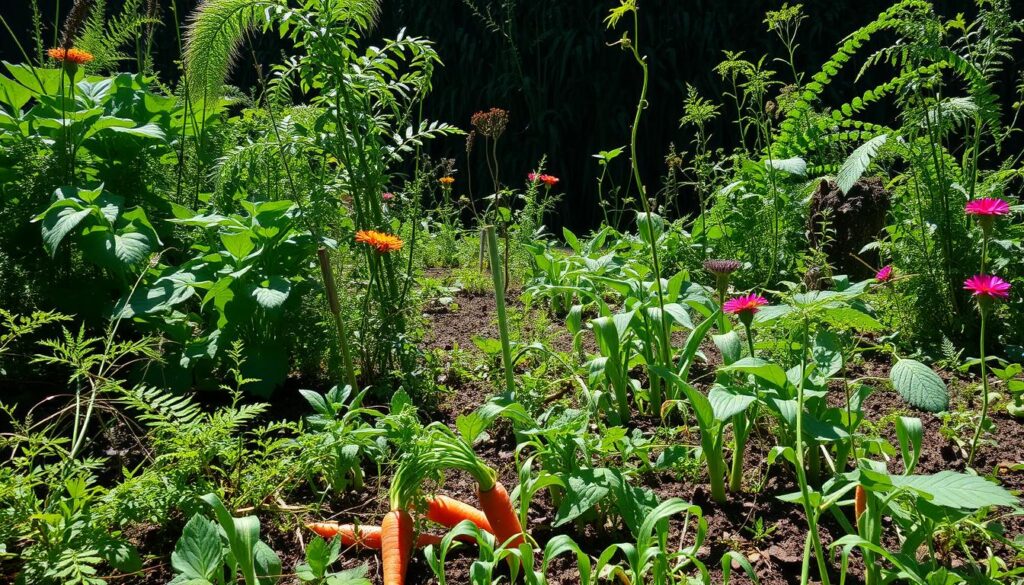
Plants to Avoid Near Carrots
When planning your garden, it’s crucial to understand the plants harmful to carrots. Some species can hinder the healthy growth of carrots and cause various issues. Companion planting restrictions play a significant role in ensuring that your carrots thrive. Below, we’ll discuss specific plants you should avoid to maintain a healthy growing environment for your carrots.
Why You Should Keep Fennel Away
Fennel poses a significant threat to carrots. This plant emits chemicals that inhibit carrot growth and compete for essential nutrients. Its presence can lead to lower yields, making it essential to keep fennel at a safe distance from your carrots.
Understanding the Risks with Dill and Parsnips
Dill is another plant you should avoid as its compounds can stunt carrot growth, leading to weak plants. Parsnips belong to the same family as carrots and can attract similar pests, creating an environment rife with potential problems. These incompatible plant pairings can negatively affect the health of your carrot crop, thus careful planning is necessary when designing your garden layout.
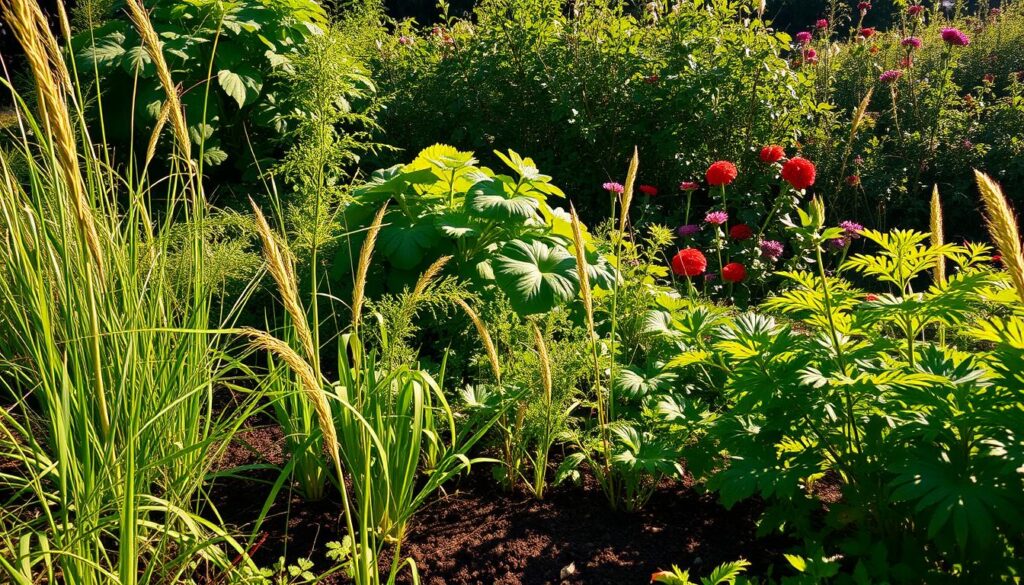
How to Plant and Care for Carrots
Planting carrots successfully starts with proper soil preparation. You need loose, well-draining soil to encourage healthy root development. Ideally, your soil should be free of rocks and debris, making it easy for the carrots to grow deeply. To enhance carrot care, consider mixing organic compost into your soil. This not only adds nutrients but also improves soil structure.
When planting carrots, ensure your garden receives ample sunlight. A minimum of six hours of direct sunlight daily significantly impacts their growth. Consistent moisture is crucial; you should water your carrots lightly but regularly, avoiding overwatering that can lead to rot.
As you implement these gardening techniques, keep an eye out for weeds. Regular weeding prevents competition for nutrients and water. Additionally, monitor for pests that may threaten your crop. Timing is essential when it comes to planting companion crops that support your carrots. These can provide shade and deter pests, resulting in a robust harvest.
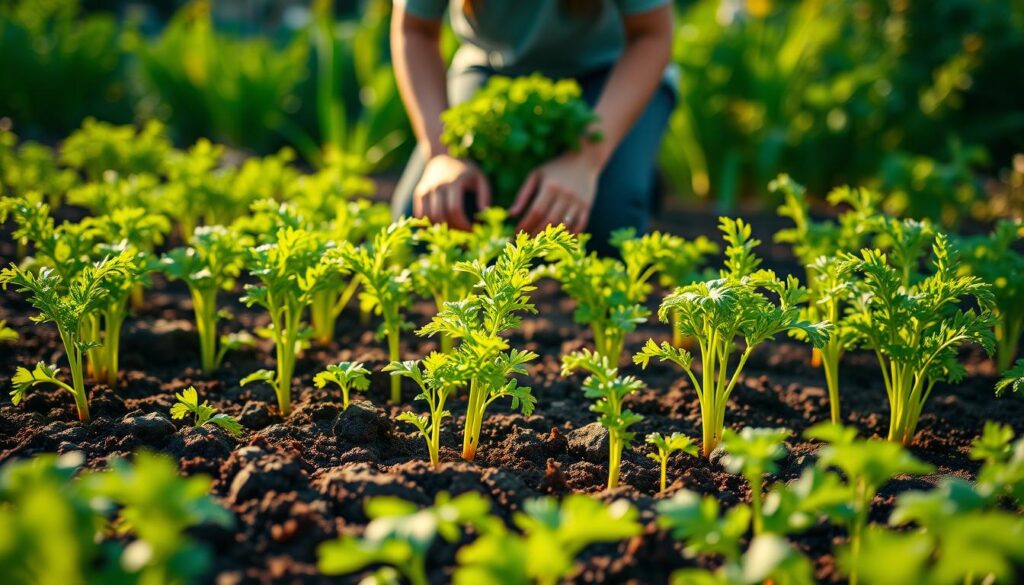
| Aspect | Details |
|---|---|
| Soil Preparation | Loose, well-draining, enriched with organic matter |
| Sunlight | A minimum of six hours of direct sunlight |
| Watering | Consistent moisture without overwatering |
| Weeding | Regular removal of weeds to reduce competition |
| Pest Management | Monitor and manage pests proactively |
Success Stories from the Garden
Many gardeners have shared their inspiring garden success stories that highlight the remarkable impact of companion planting. They express how certain combinations of plants have not only boosted their yields but also created a healthy ecosystem in their gardens. These real-world examples showcase how pairing carrots with companions like marigolds or scallions can deter pests and encourage growth.
From smaller urban spaces to expansive country gardens, companion planting benefits are evident across various settings. Gardeners report that by strategically planting together, they can maximize productivity without requiring more space. This approach allows for diverse harvests, including vibrant carrots and other nutritious vegetables.

Through these shared experiences, it becomes clear that adopting a companion planting strategy can yield significant results. Whether it’s witnessing improved plant health or simply enjoying the beauty of a flourishing garden, it’s no wonder that more individuals are embracing these methods. Consider exploring these real-world examples to inspire your gardening journey.
Boost Your Garden with Carrot Companion Plants
Utilizing the right companion plants alongside carrots can significantly enhance garden productivity. Engaging in vegetable companion planting allows you to create thriving ecosystems where plants support each other. For example, marigolds can deter harmful pests, while onions might boost the flavor of nearby carrots. By selecting the appropriate companions, you will maximize your gardening space and resource efficiency.
Impressive results stem from understanding the relationships between various plants. This dynamic approach to gardening provides visual diversity and better yields. You will find that incorporating companion planting practices leads to reduced pest issues and promotes healthier growth. With the application of these principles, you can expect a vibrant garden that delights both the eyes and palate.
| Companion Plant | Benefit | Notes |
|---|---|---|
| Marigolds | Pest deterrent | Plant around the perimeter |
| Onions | Flavor enhancement | Space accordingly for growth |
| Peas | Soil enrichment | Plant early for best results |
| Borage | Attracts beneficial insects | Plant near carrots |
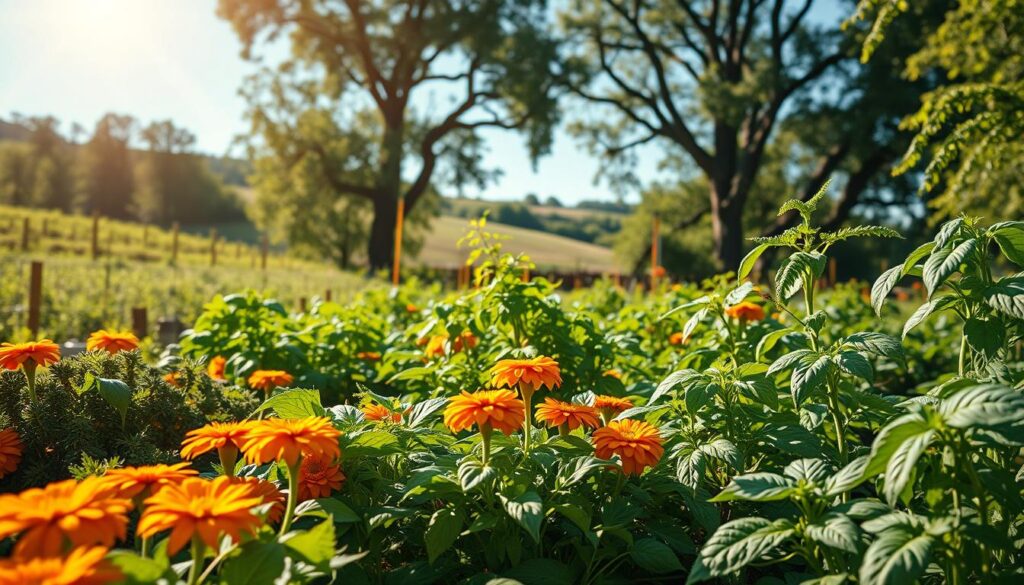
Conclusion
In summary, the conclusion on carrot companion plants highlights the significant benefits of using this gardening technique. By integrating carefully chosen companion plants into your gardening practices, you can achieve a more harmonious ecosystem in your garden. This not only enhances the health of your carrots but also improves the flavors and yields of your vegetable harvest.
Implementing these gardening best practices allows you to maximize your productivity while minimizing pest issues. The benefits recap shows that by fostering relationships between plants, such as incorporating marigolds or scallions alongside your carrots, you create a garden that nurtures growth and vitality.
Embrace the art of companion planting to ensure your garden thrives. With thoughtful planning and attention to plant pairings, you can enjoy bountiful harvests and transform your garden into a vibrant source of fresh, delicious produce.


